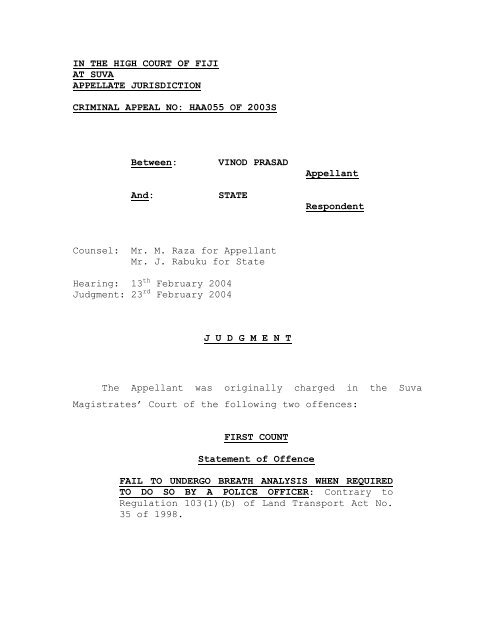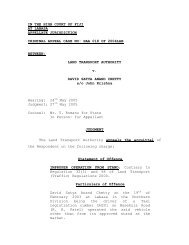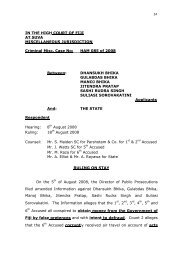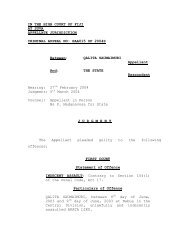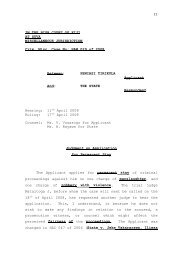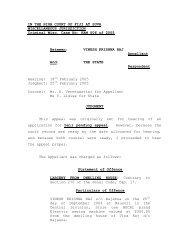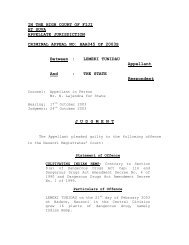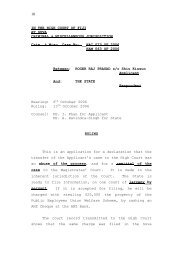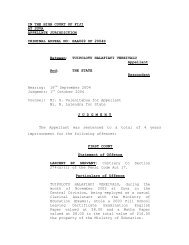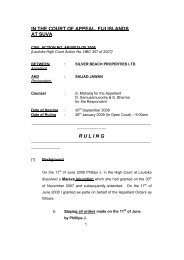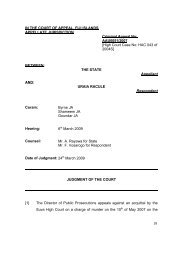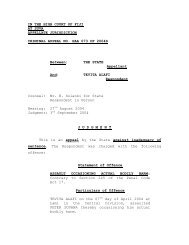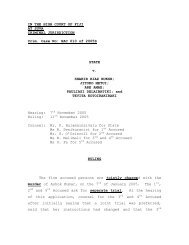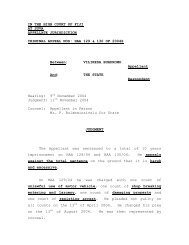Download Vinod Prasad v State Judgement - Law Fiji
Download Vinod Prasad v State Judgement - Law Fiji
Download Vinod Prasad v State Judgement - Law Fiji
You also want an ePaper? Increase the reach of your titles
YUMPU automatically turns print PDFs into web optimized ePapers that Google loves.
IN THE HIGH COURT OF FIJI<br />
AT SUVA<br />
APPELLATE JURISDICTION<br />
CRIMINAL APPEAL NO: HAA055 OF 2003S<br />
Between:<br />
And:<br />
VINOD PRASAD<br />
STATE<br />
Appellant<br />
Respondent<br />
Counsel: Mr. M. Raza for Appellant<br />
Mr. J. Rabuku for <strong>State</strong><br />
Hearing: 13 th February 2004<br />
Judgment: 23 rd February 2004<br />
J U D G M E N T<br />
The Appellant was originally charged in the Suva<br />
Magistrates’ Court of the following two offences:<br />
FIRST COUNT<br />
<strong>State</strong>ment of Offence<br />
FAIL TO UNDERGO BREATH ANALYSIS WHEN REQUIRED<br />
TO DO SO BY A POLICE OFFICER: Contrary to<br />
Regulation 103(1)(b) of Land Transport Act No.<br />
35 of 1998.
2<br />
Particulars of Offence<br />
VINOD PRASAD s/o Kashi <strong>Prasad</strong> on the 16 th day<br />
of November, 2002 at Suva in the Central<br />
Division, upon being required by a police<br />
officer namely PC 2521 Mitieli D to supply<br />
enough sample for breath analysis under the<br />
Regulation 103(1)(b) of Land Transport Act No.<br />
35 of 1998 failed to undergo that analysis in<br />
accordance with the direction of the said PC<br />
2521 Mitieli.<br />
SECOND COUNT<br />
<strong>State</strong>ment of Offence<br />
DRIVING A MOTOR VEHICLE WHILST THERE IS<br />
PRESENT IN THE BLOOD A CONCENTRATION OF<br />
ALCOHOL IN EXCESS OF THE PRESCRIBED LIMIT:<br />
Contrary to Regulation 103(1)(b) of Land<br />
Transport Act No. 35 of 1998.<br />
Particulars of Offence<br />
VINOD PRASAD s/o Kashi <strong>Prasad</strong>, on the 16 th day<br />
of November, 2002 at Suva in the Central<br />
Division, drove a motor vehicle registration<br />
number SHAVIN on Laucala Bay Road whilst there<br />
was present in 100 milliliters of his blood a<br />
concentration of 294.8 milligrams of alcohol<br />
which was in excess of the prescribed limit.<br />
He pleaded not guilty on the 9 th of December 2002.<br />
There were several adjournments, and on 19 th August 2003, it<br />
appears as a result of representations made by the Defence,<br />
the charges were withdrawn and an “amended charge” filed.<br />
The charge was read to the Appellant and he pleaded not<br />
guilty. The trial proceeded on the basis of that charge.<br />
It read as follows:
3<br />
<strong>State</strong>ment of Offence<br />
INCAPABLE OF HAVING PROPER CONTROL OF MOTOR<br />
VEHICLE DUE TO INTOXICATING LIQUOR: Contrary<br />
to Section 102 of the Land Transport Act No.<br />
35 of 1998.<br />
Particulars of Offence<br />
VINOD PRASAD s/o Kashi <strong>Prasad</strong>, on the 16 th day<br />
of November 2002 at Suva in the Central<br />
Division, whilst driving a motor vehicle<br />
registration SHAVIN was under the influence of<br />
intoxicating liquor to an extent whereby he<br />
was incapable of having proper control of the<br />
said motor vehicle.<br />
The prosecution called 8 witnesses.<br />
Viliame Takayawa was that on the 16 th<br />
The evidence of<br />
of November 2002 at<br />
about 4.30pm he was driving past the Yat Sen School from<br />
Cost-U-Less when he saw a black sports car coming behind<br />
him being driven very fast.<br />
footpath.<br />
It hit the side of the<br />
The witness thought that the car would hit his<br />
car, and he moved forward, also hitting the footpath.<br />
stopped.<br />
The black car had stopped on an island made of<br />
concrete in the middle of the road opposite the school. He<br />
then saw the Appellant come out of the driver’s seat and<br />
fall onto the grass.<br />
driver.<br />
He<br />
He stood up with the help of a taxi<br />
Constable Tamaiti attended a report that there had<br />
been an accident opposite the Yat Sen School. He said he<br />
saw a vehicle grey in colour with a number plate SHAVIN<br />
parked in a way that blocked the lane running from the<br />
University to Flagstaff. He was told that a man who was<br />
sitting in a taxi, had been the driver of the car. He
4<br />
approached him and saw that he was his superior officer<br />
Inspector <strong>Vinod</strong> <strong>Prasad</strong>. He smelt heavily of alcohol and<br />
could not control himself when he stood up. He helped him<br />
to the Police Post then told the Traffic Branch to check<br />
him.<br />
PW3 was PC Satish, a traffic officer who drew the<br />
sketch plan of the scene. The sketch shows the Appellant’s<br />
vehicle parked diagonally across the right lane of the<br />
Laucala Bay Road. The plan also shows the way the car<br />
travelled prior to the accident, but as the witness agreed,<br />
he had not witnessed the accident. However he did say that<br />
he saw the dried mark of the tyre on the grass verge and<br />
scattered soil and was able to deduce the path of the<br />
vehicle.<br />
Constable Mitieli Davui gave evidence that he attended<br />
the report and was instructed to visit the scene. He saw a<br />
private car Reg. No. SHAVIN parked on the road blocking<br />
other cars opposite the Yat Sen School. He went to the<br />
Flagstaff Police Post and saw the Appellant sitting on a<br />
bench. He told Constable Mitieli that he was the driver of<br />
the accident car. He was then asked to blow into an Alco-<br />
Test machine. He blew 6 times but produced insufficient<br />
breath samples. He was then asked to go to the Central<br />
Police Station where he was handed over to Corporal Maikeli<br />
Tuwai who tested his breath using the Dragger Test Machine.<br />
Cpl. Maikeli then gave evidence that he used the<br />
Dragger 7110 test machine to test the Appellant’s breath.<br />
He had, according to the reading, 134 micrograms of alcohol<br />
in his breath. He said in evidence that the Appellant
5<br />
smelt heavily of alcohol and was staggering but agreed that<br />
he had not said so in his statement. His evidence was also<br />
that the Dragger machines were tested every year in<br />
Australia. Under cross-examination he said that he did not<br />
know that the machines should have been re-tested in <strong>Fiji</strong>,<br />
and that only one person in <strong>Fiji</strong> was qualified to re-test<br />
the machines.<br />
PW6 was Senior Superintendent Jerome Kanimea who<br />
interviewed the Appellant under caution. In that<br />
statement, taken on the 17 th of November 2002 the Appellant<br />
said that on the 16 th of November he had drunk “a few beers”<br />
at the Palm Club in Nasese. He left the Club at 5pm in the<br />
vehicle SHAVIN. His nephew Nilesh Chad was driving. He<br />
denied that he was the driver and said he did not know what<br />
happened because he was asleep at the time. When he was<br />
charged he said again that he was not the driver of the<br />
vehicle.<br />
Inspector Alusio Waqa, who was the charging officer<br />
said he saw the Appellant on the 16 th of November at Central<br />
Police Station. He said that the Appellant needed to be<br />
supported by two police officers when he was brought into<br />
the Station, that the Appellant was so drunk that he could<br />
not control himself. He then told Cpl. Maikeli to conduct<br />
the breathalyser test and locked the Appellant in a cell<br />
overnight because he was too drunk to be interviewed at<br />
that time.
6<br />
Under cross-examination the Inspector said that he had<br />
not recorded any statement. He said that the Dragger<br />
machines were tested in Australia but because of <strong>Fiji</strong>’s<br />
different climatic conditions, should be re-tested in <strong>Fiji</strong>.<br />
At the end of the prosecution case, the defence made<br />
submissions that there was no case to answer. The learned<br />
Magistrate concluded that there was and put the Appellant<br />
to his defence. The Appellant remained silent and called<br />
Tauz Khan a technical engineer and managing director of<br />
Safe Way Electronics Ltd. He said that he was licensed to<br />
repair the breathalyser machines, to re-calibrate them and<br />
have them verified by the Weights and Measures Department.<br />
He said that he used to test the machines annually until 3<br />
years previously when the Department decided to have them<br />
tested in Australia. He said that in his opinion the<br />
machines ought to be re-tested in <strong>Fiji</strong> because of the<br />
climatic conditions (temperature humidity and atmospheric<br />
pressure) which affected accuracy of readings. He said<br />
that such inaccuracy might lead to a variance of 10-15<br />
grams. Under cross-examination he agreed that the<br />
certificate of verification for the machines had been<br />
signed by the Chief Inspector of Weights and Measures, and<br />
that he had not been involved with the machines for the<br />
past 3 years.<br />
In closing submissions, counsel submitted that the<br />
breathalyser machines were unreliable, that the Appellant<br />
had not been examined by a senior police officer or medical<br />
practitioner, and that there was no evidence that the<br />
Appellant had been drunk and incapable of driving.
7<br />
The <strong>State</strong> said that the result of the Dragger machines<br />
was not necessary for conviction, but that there was<br />
sufficient evidence that the machines were reliable. The<br />
<strong>State</strong> also said that there were other evidence as to the<br />
Appellant’s manner of driving, and of his drunk condition<br />
to justify conviction. Further, he said that there was no<br />
real dispute that the Appellant was the driver of the car<br />
at the time of the accident.<br />
The learned Magistrate delivered judgment on 18 th<br />
September 2003. After summarising the evidence, he<br />
concluded that the evidence of the prosecution witnesses<br />
showed that the Appellant was incapable of having proper<br />
control of the vehicle due to intoxication, that he was<br />
driving the vehicle SHAVIN, that he caused the accident,<br />
that the breathalyser tests proved that he had in his blood<br />
an excessive amount of alcohol, and that the Appellant had<br />
received proper notification of the prosecution. He<br />
convicted the Appellant accordingly and fined him the sum<br />
of $1000 (in default 3 months imprisonment) and<br />
disqualified him from driving for 12 months “on the<br />
condition that you should only be allowed to drive your car<br />
registration SHAVIN to work from 6am to 6pm at your working<br />
days with effect from today.”<br />
The Appellant’s amended petition of appeal contains<br />
the following grounds of appeal:<br />
1.a)<br />
In relying on the evidence of the<br />
Dragger Test machine to find the<br />
Appellant guilty of the charge;
8<br />
b) In relying on the evidence of the<br />
Police Officers to find the Appellant<br />
guilty of the charge.<br />
c) In failing to consider Tauz Khan’s<br />
evidence which was crucial to the<br />
Defence/Appellant’s case.<br />
d) On relying totally on the evidence in<br />
examination in chief to find the case<br />
proved beyond reasonable doubt.<br />
2. That the learned trial magistrate failed<br />
to consider that evidence given in court<br />
by the prosecution witnesses were not in<br />
the witnesses statement to the Police.<br />
3. That the learned trial magistrate failed<br />
to consider the contradictions in<br />
prosecution’s case.<br />
4. That the learned trial magistrate failed<br />
to consider and/or attach any weight to<br />
the evidence in cross-examination of the<br />
prosecution witnesses.<br />
5. That the learned trial magistrate failed<br />
to give any reasons why he believed the<br />
prosecution witnesses.<br />
6. That the learned trial magistrate<br />
shifted the burden of proof on the<br />
defence when convicting the Appellant.<br />
7. That the learned trial magistrate erred<br />
in law in convicting and sentencing the<br />
Appellant whereas the <strong>State</strong>ment of<br />
Offence does not disclose any offence.<br />
8. That the fine of $1,000 was harsh and<br />
excessive.<br />
These grounds can be put into three broad categories;<br />
one, the objections to the breathalyser test results, two,<br />
the submission that a conviction under section 102 of the
9<br />
Land Transport Act is impossible without a medical/police<br />
examination, and three, that the prosecution witnesses were<br />
so unreliable that no weight should have been put on their<br />
evidence. I deal with these in turn.<br />
The Breathalyser Test<br />
follows:<br />
Section 102 of the Land Transport Act provides as<br />
“(1) A person who drives a motor vehicle or<br />
is in charge of a motor vehicle while under<br />
the influence of intoxicating liquor or any<br />
drug to such an extent as to be incapable of<br />
having proper control of the motor vehicle<br />
commits an offence and is liable on<br />
conviction to the prescribed penalty.<br />
(2) If a police officer is of the opinion<br />
that a person who is driving or attempting<br />
to drive or is for the time being in charge<br />
of a motor vehicle is, by reason of his<br />
physical or mental condition, however<br />
arising, incapable of having proper control<br />
of the motor vehicle, the police officer may<br />
–<br />
(a)<br />
(b)<br />
forbid that person to drive the<br />
motor vehicle;<br />
direct that person to deliver up<br />
to the police officer forthwith<br />
all ignition keys and other keys<br />
of the motor vehicle that are in<br />
that person’s possession; and<br />
(c) take such steps as may be<br />
necessary to render the motor<br />
vehicle immobile or to remove it<br />
to a place of safety.
10<br />
(3) A person who fails to comply with a<br />
direction given to him under subsection (2)<br />
or does an act that is for the time being<br />
forbidden under that subsection is guilty of<br />
an offence against this Act, but no person<br />
shall be convicted of an offence under this<br />
subsection unless the court before which he<br />
is charged is satisfied that the police<br />
officer had reasonable grounds for believing<br />
that, in all the circumstances of the case,<br />
the direction or prohibition was necessary<br />
in the interests of the defendant, or of any<br />
other person, or of the public.<br />
(4) Subject to subsection (5), if a police<br />
officer exercises the powers conferred by<br />
subsection (2), the police officer shall<br />
retain the ignition keys and other keys of<br />
the motor vehicle and cause the motor<br />
vehicle to be kept immobile or in a place of<br />
safety until such time as, in the police<br />
officer’s opinion, the person referred to in<br />
subsection (2) is capable of having proper<br />
control of the motor vehicle.<br />
(5) A person who is directed or forbidden to<br />
do anything, pursuant to subsection (2),<br />
shall, at the time when the direction or<br />
prohibition is given or imposed or at any<br />
time thereafter, be informed by the police<br />
officer that –<br />
(a) he is entitled to have his<br />
capability to have proper control<br />
of the motor vehicle determined by<br />
a police officer (in this<br />
subsection referred to as “the<br />
senior police officer”) of a higher<br />
rank than the police officer who<br />
gave the direction or imposed the<br />
prohibition, if the last-mentioned<br />
police officer is of a rank lower<br />
than inspector; or
11<br />
(b) he is entitled to request an<br />
examination by a qualified medical<br />
practitioner, and if it is<br />
reasonably practicable that the<br />
request be granted the police<br />
officer who gave the direction or<br />
imposed the prohibition shall make<br />
the necessary arrangements<br />
accordingly.<br />
(6) If a police inspector or other senior<br />
police officer or medical practitioner, as<br />
the case may be, certifies that he is of the<br />
opinion that a person is capable of having<br />
proper control of a motor vehicle, the<br />
police officer who has possession of the<br />
ignition keys and other keys of the motor<br />
vehicle shall forthwith return them to the<br />
person and, if the motor vehicle has been<br />
rendered immobile, shall forthwith cause it<br />
to be returned to running order.”<br />
Section 103 of the Act provides for a separate offence<br />
of driving a motor vehicle while there is more than the<br />
prescribed concentration of alcohol in the blood. The Land<br />
Transport (Breath Tests and Analyses) Regulations 2000<br />
provide (as amended by Legal Notice 148 of 2000) as<br />
follows:<br />
“3(1) For the purpose of section 103(1)(a) the<br />
prescribed concentration of alcohol is 80<br />
milligrams of alcohol in 1000 millilitres of<br />
breath.<br />
(2) Evidence that there is alcohol in the<br />
blood in excess of the prescribed<br />
concentration at a relevant time may be given<br />
by reference to a sample of the person’s blood<br />
taken with his or her consent, or by reference<br />
to the reading on a breath analysing<br />
instrument in accordance with sub-regulation<br />
(3).
12<br />
(3) A reading or a breath analysing instrument<br />
in microgrammes of alcohol per 100 millilitres<br />
of blood is to be multiplied by 2.2 in order<br />
to arrive at the number of milligrams of<br />
alcohol in 100 millilitres of blood.”<br />
Section 103(1) of the Act provides:<br />
“(1) A person who –<br />
(a)<br />
(b)<br />
drives or attempts to drive a motor<br />
vehicle or is in charge of a motor<br />
vehicle while more than the prescribed<br />
concentration of alcohol is present in<br />
his blood; or<br />
fails or refuses to undergo a breath<br />
test or breath analysis when required<br />
to do so by a police officer<br />
commits an offence.”<br />
Section 103(3) provides:<br />
“A person convicted of an offence –<br />
(a)<br />
(b)<br />
under section 102(1) is not liable to<br />
be convicted of an offence under<br />
subsection (1) of this section arising<br />
out of the same circumstances;<br />
under subsection (1) of this section is<br />
not liable to be convicted of an<br />
offence under section 102(1) arising<br />
out of the same circumstances.”<br />
It seems clear, on a reading of these provisions, that<br />
on finding a driver with more than the prescribed amount of<br />
alcohol in his breath, the prosecution must choose which<br />
provision to charge him/her under. Charging under both<br />
sections 102 and 103 is not possible because of the effect
13<br />
of section 103(3)(a) and (b), unless they are drafted in<br />
the alternative. Further, although the <strong>State</strong> submitted<br />
that a conviction on section 103 is possible as a lesser<br />
offence, even if all the ingredients of section 102 are not<br />
present, it does not appear to me that the ingredients of a<br />
section 103 offence of driving while in excess of the<br />
prescribed limit of alcohol in the breath, are necessarily<br />
some of the ingredients of a section 102 offence. The<br />
prosecution, to prove a section 102 offence, does not have<br />
to lead evidence, or to prove that the driver had more than<br />
80 milligrams of blood alcohol. A person can be found<br />
drunk and incapable under section 102 of the Act without<br />
any evidence of blood or breath alcohol.<br />
What are the elements of the section 102(1) offence<br />
Firstly, that the accused drove a vehicle, secondly that at<br />
the time of driving he was under the influence of alcohol,<br />
and thirdly that he was thereby incapable of having proper<br />
control of the motor vehicle. There is nothing in the<br />
section which requires proof of the exact level of blood<br />
alcohol of the accused, but there is also nothing in the<br />
section which prohibits such evidence being led.<br />
Section 102(5) provides that a person is “entitled to<br />
have his capability to have proper control of the motor<br />
vehicle determined by a police officer” or to “request an<br />
examination by a qualified medical practitioner”, but that<br />
entitlement is specifically in relation to a police<br />
officer’s powers, under section 102(2) to forbid the driver<br />
to drive, and direct him/her to give up his car keys. It<br />
is a procedural safeguard in relation to a person who is<br />
forbidden to drive because he/she is suspected of being
14<br />
drunk and incapable. Section 102(5) does not provide that<br />
the only way that incapability to drive can be judged, is<br />
the senior police officer’s determination or a medical<br />
examination.<br />
Insofar as <strong>State</strong> counsel purported to agree with the<br />
Appellant that a conviction was not possible under section<br />
102(1) without such examination, I consider that he made<br />
that concession in error. In this case, the Appellant did<br />
not seriously argue that he was not the driver of SHAVIN at<br />
the time of the accident. Nor did counsel make that<br />
submission on appeal. There was good evidence that the<br />
Appellant was the driver. Further, there was no real<br />
dispute that the Appellant had drunk some alcohol before<br />
driving the car. What was in dispute was whether he was<br />
thereby incapable of controlling the vehicle.<br />
Section 39 of the Traffic Act (now repealed) read:<br />
“Any person who, when driving or attempting to<br />
drive or when in charge of a motor vehicle on<br />
a road or other public place, is under the<br />
influence of drink or drug to such an extent<br />
as to be incapable of having proper control of<br />
the vehicle shall be guilty of an offence…”<br />
I see no difference between the repealed offence and<br />
the section 102(1) offence. I consider therefore that the<br />
evidential requirements would be identical. As such, the<br />
prosecution, to prove a section 102(1) offence needs to<br />
lead evidence of consumption of alcohol (admission, smell<br />
of liquor, unsteady gait) and of manner of driving. If<br />
there is expert evidence of the latter, well and good.<br />
However, whether or not there is expert evidence of
15<br />
incapability, the court must decide on all the evidence,<br />
the question of ability to control the vehicle. Even<br />
evidence of a breathalyser test is only one consideration<br />
in the case. This is because the prosecution must prove<br />
not only the consumption of alcohol, but also resulting<br />
inability to control the vehicle. (R –v- Hunt (Reginald)<br />
(1980) RTR 29, MacNeill –v- Fletcher (1966) JC 18, R –v-<br />
Hawkes 22 Cr. App. R. 172). Further, where a suspect has<br />
caused an accident as a result of the consumption of<br />
alcohol, in an area where the breathalyser equipment is not<br />
available, he/she may still be charged under section<br />
102(1).<br />
The evidence in this case was that the vehicle came<br />
down Laucala Bay Road, hit the side of the footpath, and<br />
came to rest on a concrete island in the middle of the<br />
lane. PW1, Viliame Takayawa also said the vehicle came<br />
very fast. In cross-examination he agreed that he had not<br />
said that in his statement to the police. Nor had he said<br />
that the car was on the island. However there was no real<br />
dispute that the car was found parked in the middle of the<br />
road as shown on the sketch plan. There were tyre marks<br />
suggesting an erratic journey from the Laucala Bay Road,<br />
over the grass verge, and into the middle of the road.<br />
That was the evidence of manner of driving. That<br />
evidence together with the evidence of the smell of alcohol<br />
(PW1, PW2, PW4, PW5 and PW7) and of staggering and<br />
inability to control himself were sufficient on their own<br />
to allow the learned Magistrate to conclude that the<br />
Appellant was drunk and unable to control his vehicle.
16<br />
However the prosecution also led evidence of the<br />
breath tests. The evidence was that Cpl. Maikeli used a<br />
Dragger 7110 test machine to test the Appellant’s breath.<br />
The result was that there were 134 micrograms of alcohol in<br />
his breath. If accepted, this was well in excess of the<br />
prescribed limit.<br />
The defence case was that the Dragger machine was<br />
unreliable because it had not been tested in <strong>Fiji</strong>. The<br />
defence led the evidence of an expert who used to test the<br />
machines, but who no longer does so because the tests are<br />
now carried out in Australia. The evidence was that the<br />
machines are being tested annually but in Australia.<br />
Of course, the test result was not the sole basis of<br />
the conclusion reached by the court. Further, the expert<br />
called by the defence said that the extent of the<br />
inaccuracy was as much as 30 micrograms. I note that even<br />
if the result was inaccurate by 30 micrograms, the<br />
Appellant was still in excess of the prescribed limit.<br />
Lastly, the learned Magistrate obviously considered that a<br />
3 year lapse in working with the Dragger machines, rendered<br />
the expert evidence less than compelling. This is a<br />
conclusion he was entitled to reach. Expert evidence, like<br />
other evidence must be weighed and considered by the court<br />
in reaching an ultimate conclusion. What weight should be<br />
put on any expert evidence is a matter for the trial court.<br />
In this case the learned Magistrate clearly decided that<br />
the reading on the Dragger machine was reliable despite the<br />
evidence of the expert. This is a conclusion he was<br />
entitled to reach, after hearing all the evidence. Indeed,<br />
the result of the Dragger machine could not have been
17<br />
conclusive because it is evidence only of consumption of<br />
liquor, not of incapability. Insofar as there is no real<br />
dispute about consumption, the Dragger result was not of<br />
central importance to the case. Grounds (a), (b) and (c)<br />
are dismissed. Further, the submission that a section 102<br />
conviction was impossible without a formal police or<br />
medical test, is also unsuccessful for the reasons I have<br />
given.<br />
Contradictions in the Prosecution Case<br />
The crux of counsel’s submissions are that the<br />
witnesses gave evidence of details which were not in their<br />
statements. One witness (the charging officer) made no<br />
statement at all.<br />
Indeed, there is no law that requires witnesses to<br />
give evidence strictly in accordance with their statements.<br />
Most witnesses give evidence in greater or lesser detail in<br />
court. Much depends on their memories, the skill of<br />
whoever took their statement and the way their evidence is<br />
led in court. Inconsistencies between statement and<br />
evidence may assist the court in weighing up reliability<br />
and credibility. However the out-of-court statements are<br />
not evidence. What is said in the witness box is evidence.<br />
In this case, the learned Magistrate clearly believed the<br />
witnesses despite the lack of detail in their statements.<br />
One witness (PW1) said that he gave his statement with some<br />
reluctance because he was afraid of being victimised. The<br />
learned Magistrate was entitled to accept the evidence of<br />
the prosecution witnesses, not only because he heard them<br />
and saw their demeanour, but also, as he said, because the
18<br />
evidence was consistent with the prosecution charges.<br />
Finally, one police officer (the charging officer) gave no<br />
statement at all. In practical terms, this might have been<br />
unsurprising if the only evidence given by him was of the<br />
charge statement which had already been disclosed to<br />
counsel. However he also gave evidence that the Appellant<br />
was drunk when he was brought into the Central Police<br />
Station and had to be supported by two other police<br />
officers. Obviously this evidence came as a surprise to<br />
counsel and if the prosecutor knew he was going to lead<br />
this evidence, then it should have been recorded in a<br />
statement and disclosed to the defence. Alternatively if<br />
no statement was recorded, then counsel should have been<br />
allowed to seek an adjournment to prepare crossexamination.<br />
Despite the lack of disclosure of Inspector Waqa’s<br />
evidence however, I see no prejudice to the Appellant.<br />
Counsel who did not seek an adjournment, cross-examined<br />
vigorously, along the same lines as he had cross-examined<br />
other prosecution witnesses. Further IP Waqa said very<br />
little more than the other police witnesses as to the<br />
Appellant’s state of intoxication.<br />
For all these reasons I find that the learned<br />
Magistrate was entitled to rely on the prosecution<br />
evidence, and was entitled to come to the conclusion he<br />
did. Indeed, on a reading of the court record, the<br />
evidence of intoxication, and of the manner of driving,<br />
appears to be both consistent and compelling.
19<br />
In respect of counsel’s submissions that he put too<br />
much weight on the prosecution evidence and failed to give<br />
reasons for his decision, I cannot agree. The prosecution<br />
called 7 witnesses and the learned Magistrate summarised<br />
the evidence of each one. He also summarised the evidence<br />
of the one defence witness. The reasons for his decision<br />
to convict are clear on page 35 of the court record. He<br />
found that the Appellant was not only drunk, but that he<br />
was incapable of driving his motor vehicle. He decided to<br />
accept the validity of the Dragger Alcotest result in<br />
relation to the Appellant’s state on the 16 th of November<br />
2002. I do not consider that he erred.<br />
In his amended grounds of appeal, the Appellant does<br />
not pursue the issue of the Notice of Intended Prosecution.<br />
This appeal against conviction is dismissed.<br />
Sentence<br />
The maximum sentence under section 102(1) is $5000<br />
fine and disqualification for 5 years. Counsel made no<br />
submissions on sentence at the hearing of this appeal, but<br />
I consider a fine of $1000 in the circumstances of this<br />
case to be far from excessive. The evidence was that the<br />
Appellant was so drunk he was staggering and could not<br />
control himself. His manner of driving was so erratic that<br />
it was fortunate that no one was injured. He was driving<br />
in the afternoon on a busy road and could have caused<br />
injury and damage. The fine is not excessive nor wrong in<br />
principle.
20<br />
However, I have questions as to the lawfulness of the<br />
order of “partial” disqualification. As I did not request<br />
counsel for submissions on the disqualification, I intend<br />
to give them an opportunity to make such submissions. I<br />
will rule on sentence thereafter. The appeal against<br />
conviction is dismissed.<br />
…………………………………………………<br />
Nazhat Shameem<br />
JUDGE<br />
At Suva<br />
23 rd February 2004


